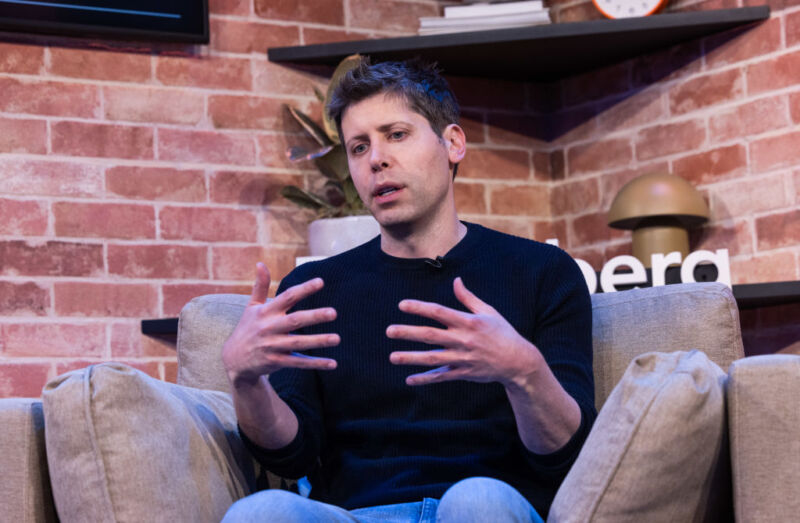OpenAI CEO Sam Altman pushed to explain recent changes to safety efforts.

OpenAI is facing increasing pressure to prove it’s not hiding AI risks after whistleblowers alleged to the US Securities and Exchange Commission (SEC) that the AI company’s non-disclosure agreements had illegally silenced employees from disclosing major safety concerns to lawmakers.
In a letter to OpenAI yesterday, Senator Chuck Grassley (R-Iowa) demanded evidence that OpenAI is no longer requiring agreements that could be “stifling” its “employees from making protected disclosures to government regulators.”
Specifically, Grassley asked OpenAI to produce current employment, severance, non-disparagement, and non-disclosure agreements to reassure Congress that contracts don’t discourage disclosures. That’s critical, Grassley said, so that it will be possible to rely on whistleblowers exposing emerging threats to help shape effective AI policies safeguarding against existential AI risks as technologies advance.
Grassley has apparently twice requested these records without a response from OpenAI, his letter said. And so far, OpenAI has not responded to the most recent request to send documents, Grassley’s spokesperson, Clare Slattery, told The Washington Post.
“It’s not enough to simply claim you’ve made ‘updates,’” Grassley said in a statement provided to Ars. “The proof is in the pudding. Altman needs to provide records and responses to my oversight requests so Congress can accurately assess whether OpenAI is adequately protecting its employees and users.”
In addition to requesting OpenAI’s recently updated employee agreements, Grassley pushed OpenAI to be more transparent about the total number of requests it has received from employees seeking to make federal disclosures since 2023. The senator wants to know what information employees wanted to disclose to officials and whether OpenAI actually approved their requests.
ARS VIDEO
How The Callisto Protocol’s Gameplay Was Perfected Months Before Release
Along the same lines, Grassley asked OpenAI to confirm how many investigations the SEC has opened into OpenAI since 2023.
Together, these documents would shed light on whether OpenAI employees are potentially still being silenced from making federal disclosures, what kinds of disclosures OpenAI denies, and how closely the SEC is monitoring OpenAI’s seeming efforts to hide safety risks.
“It is crucial OpenAI ensure its employees can provide protected disclosures without illegal restrictions,” Grassley wrote in his letter.
He has requested a response from OpenAI by August 15 so that “Congress may conduct objective and independent oversight on OpenAI’s safety protocols and NDAs.”
OpenAI did not immediately respond to Ars’ request for comment.
On X, Altman wrote that OpenAI has taken steps to increase transparency, including “working with the US AI Safety Institute on an agreement where we would provide early access to our next foundation model so that we can work together to push forward the science of AI evaluations.” He also confirmed that OpenAI wants “current and former employees to be able to raise concerns and feel comfortable doing so.”
“This is crucial for any company, but for us especially and an important part of our safety plan,” Altman wrote. “In May, we voided non-disparagement terms for current and former employees and provisions that gave OpenAI the right (although it was never used) to cancel vested equity. We’ve worked hard to make it right.”
In July, whistleblowers told the SEC that OpenAI should be required to produce not just current employee contracts, but all contracts that contained a non-disclosure agreement to ensure that OpenAI hasn’t been obscuring a history or current practice of obscuring AI safety risks. They want all current and former employees to be notified of any contract that included an illegal NDA and for OpenAI to be fined for every illegal contract.
Sam Altman accused of being shady about AI safety
Calls for more transparency from OpenAI go beyond lawmakers, though. On the day before Grassley sent his letter, OpenAI CEO Sam Altman posted a statement on X claiming that OpenAI has dedicated ample resources to safety efforts since last July, which X fact checkers labeled as misleading amid public outcry in the comments.
“As we said last July, we’re committed to allocating at least 20 percent of the computing resources to safety efforts across the entire company,” Altman wrote, triggering a community note to be added, which enough X readers from biased viewpoints agreed provided “more context.”
The community note pointed out that Altman was referring to a July blog specifically confirming that OpenAI was “dedicating 20 percent of the compute” to its superalignment team. Because that team has since been disbanded and chief scientists working on superalignment left the company, X commenters called out Altman’s claim as misleading the public about what computing resources are actually being dedicated to OpenAI’s now vaguely defined “safety efforts.”
Some X commenters asked for more details about what OpenAI’s safety efforts entailed now. In a July 31 letter responding to five other senators asking questions about AI safety, OpenAI offered a more detailed explanation of its safety efforts. The company also clarified the claim made by Altman that X had flagged as needing “more context,” writing that the blog’s reference to computing resources was never supposed to only refer to the superalignment team.
“To further our safety research agenda, last July we committed to allocate at least 20 percent of the computing resources we had secured to AI safety over a multi-year period,” OpenAI’s letter to senators said. “This commitment was always intended to apply to safety efforts happening across our company, not just to a specific team.”
This remains somewhat confusing to some since OpenAI’s blog explicitly said that OpenAI was “dedicating 20 percent of the compute we’ve secured to date over the next four years to solving the problem of superintelligence alignment.” At that time, OpenAI said that its “chief basic research bet” was its former superalignment team, “which needed the computing resources because “getting this right is critical to achieve our mission.”
One X user, @AISafetyMemes, asked OpenAI why it had shifted the computing resources away from superalignment, and “across the entire company,” if superalignment was “the most important problem by far” to safeguard against AI risks.
OpenAI did not respond to the meme account but previously had described the superalignment team as critical to AI safety, because society needs “scientific and technical breakthroughs to steer and control AI systems much smarter than us.”
OpenAI details safety efforts
In OpenAI’s letter to senators, Chief Strategy Officer Jason Kwon told lawmakers that OpenAI safeguards against risks by collaborating “with external experts to evaluate and red team our models.” That includes consulting with more than 100 external experts who “helped to assess risks associated with our latest model, GPT-4o.”
“Red teaming findings and safety mitigations are publicly available in the system cards that accompany our models,” Kwon wrote, and OpenAI has published research on “measuring the chemical, biological, radiological, and nuclear (CBRN) risks associated with AI systems,” “estimating the extent to which different occupations and industries might be impacted by language models,” “assessing the implications of language models for influence operations,” and explaining “the interpretability of AI systems’ decision-making.”
To further ensure AI safety, Kwon said that OpenAI conducts iterative deployments, releasing new features like its Sora video model or Voice Engine to a limited group before releasing them widely to the public.
“This strategy allows us to get feedback from people outside of OpenAI, update our safety guardrails as needed, and give the public a sense of upcoming AI capabilities before making our models fully available,” Kwon wrote.
For employees working on new features or models who still fear retaliation for raising safety concerns, Kwon said that OpenAI established an Integrity Line in March. Through that channel, employees can anonymously report concerns when they’re “uncomfortable raising issues through other existing channels.”
While OpenAI has said that employees can speak freely about any concerns, it is clear that some information still cannot be shared if OpenAI deems it to be a security risk.
“OpenAI continues to distinguish between raising concerns and revealing company trade secrets,” Kwon wrote. “The latter (subject to the right to make protected disclosures) remains prohibited under confidentiality agreements for current and former employees. We believe this prohibition is particularly important given our technology’s implications for US national security.”
Considering this exception allowing OpenAI to deny some federal disclosures, it seems likely that Grassley is hoping to find out if OpenAI is possibly improperly denying disclosures by claiming it’s protecting trade secrets. Grassley’s letter made it clear that the senator is worried about “risks with the company’s self-policing of safety.”




